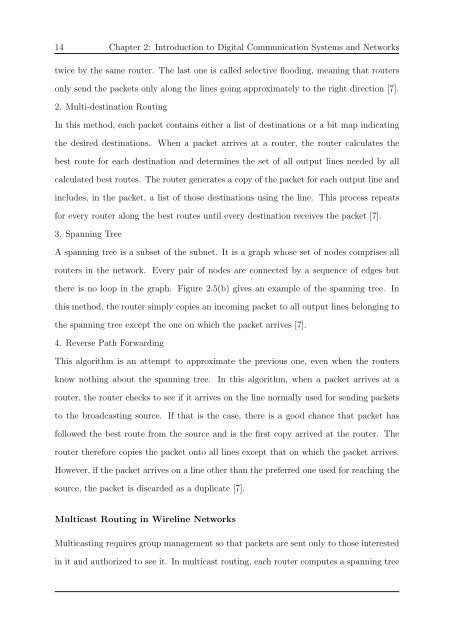Network Coding and Wireless Physical-layer ... - Jacobs University
Network Coding and Wireless Physical-layer ... - Jacobs University
Network Coding and Wireless Physical-layer ... - Jacobs University
Create successful ePaper yourself
Turn your PDF publications into a flip-book with our unique Google optimized e-Paper software.
14 Chapter 2: Introduction to Digital Communication Systems <strong>and</strong> <strong>Network</strong>s<br />
twice by the same router. The last one is called selective flooding, meaning that routers<br />
only send the packets only along the lines going approximately to the right direction [7].<br />
2. Multi-destination Routing<br />
In this method, each packet contains either a list of destinations or a bit map indicating<br />
the desired destinations. When a packet arrives at a router, the router calculates the<br />
best route for each destination <strong>and</strong> determines the set of all output lines needed by all<br />
calculated best routes. The router generates a copy of the packet for each output line <strong>and</strong><br />
includes, in the packet, a list of those destinations using the line. This process repeats<br />
for every router along the best routes until every destination receives the packet [7].<br />
3. Spanning Tree<br />
A spanning tree is a subset of the subnet. It is a graph whose set of nodes comprises all<br />
routers in the network. Every pair of nodes are connected by a sequence of edges but<br />
there is no loop in the graph. Figure 2.5(b) gives an example of the spanning tree. In<br />
this method, the router simply copies an incoming packet to all output lines belonging to<br />
the spanning tree except the one on which the packet arrives [7].<br />
4. Reverse Path Forwarding<br />
This algorithm is an attempt to approximate the previous one, even when the routers<br />
know nothing about the spanning tree. In this algorithm, when a packet arrives at a<br />
router, the router checks to see if it arrives on the line normally used for sending packets<br />
to the broadcasting source. If that is the case, there is a good chance that packet has<br />
followed the best route from the source <strong>and</strong> is the first copy arrived at the router. The<br />
router therefore copies the packet onto all lines except that on which the packet arrives.<br />
However, if the packet arrives on a line other than the preferred one used for reaching the<br />
source, the packet is discarded as a duplicate [7].<br />
Multicast Routing in Wireline <strong>Network</strong>s<br />
Multicasting requires group management so that packets are sent only to those interested<br />
in it <strong>and</strong> authorized to see it. In multicast routing, each router computes a spanning tree

















